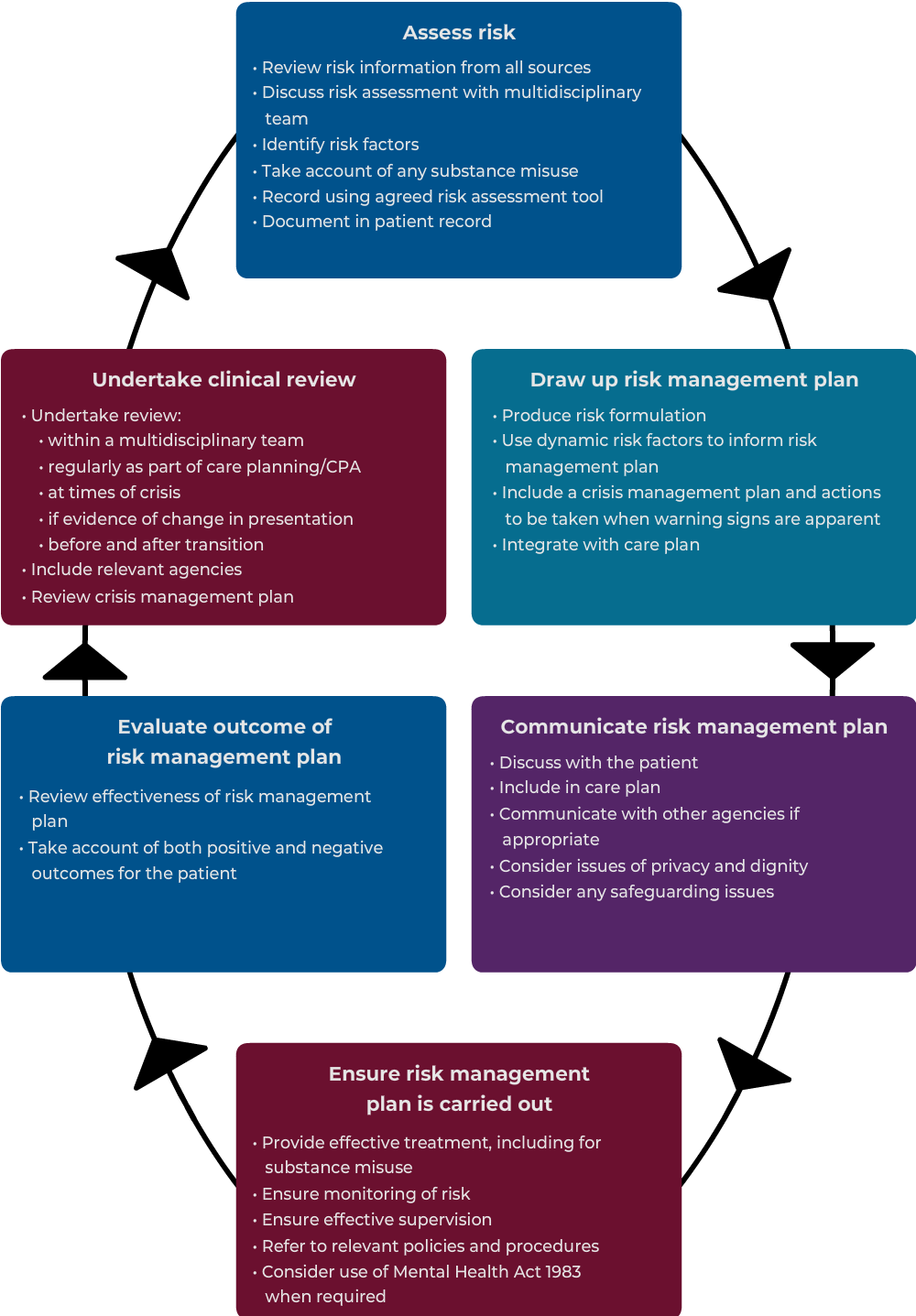Managing risk
General principles
- A clinician, having identified a risk of dangerous behaviour, has a responsibility to take action with a view to ensuring that risk is reduced and managed effectively.
- A management plan should seek to change the balance between risk and safety.
- The clinician should aim to make the patient feel safer and less distressed.
- Sensitive use of empathy and compassion should allow the patient to feel understood and, potentially, more contained.
In all cases:
- Has the assessment and management plan been adequately recorded?
- Has the assessment and management plan been adequately communicated?
- Does the assessment and management plan include a specific treatment plan, including medications if appropriate?
- If the resources considered necessary to fulfil the optimal management plan are not available and a compromise plan is adopted, this must be recorded.
- Has account been taken of any special needs of the patient (e.g. limited knowledge of English, physical problems, intellectual disability)?
- Does the plan offer the opportunity for social recovery and therapeutic optimism?
- Has a date for review of the plan been agreed, recorded and conveyed to all who need to know?
- Have the patient and carers been involved in the negotiation of the plan?
- Has the patient’s GP been informed? Do you need to speak to the GP?
- What information should be shared and with whom? Does the need to protect the public outweigh the duty of confidence to the patient?
- If the police are to be informed, can they record a marker or flag for violence and include contact details for the mental health service?
The management plan
- A management plan should promote safety. Depending on the setting, clinicians might need to consider the following questions when negotiating a management plan.
- Is the person capacitous?
- Will the person engage and how much? Is it possible to agree a safety plan? (Record lack of engagement.)
- Is home treatment feasible or is admission necessary?
- What community supports are available (e.g. family, carers, community mental health nurses, approved mental health professionals, probation)?
- Do carers and family feel supported and do they have easy, timely access to help?
- What psychological interventions might be helpful?
- What level of observation is required?
- Should the person be detained?
- The Mental Health Act 1983 can be a very effective tool in managing risk.
- How should medication be used? Is rapid tranquillisation necessary?
- Has an intervention for substance or alcohol misuse been proposed?
- Is seclusion or restraint necessary?
- What level of physical security is needed?
- How should any further episodes of violence be managed?
- Is the risk of violence imminent? What antecedents are there to look out for?
- Has a Care Programme Approach been implemented?
- Has a Community Treatment Order been considered?
- Has an assertive outreach approach been considered?
- Has everyone from carers to professionals* been adequately consulted and informed about the risks present and the interventions required? Are they realistic in their expectations?
*General practitioners (GPs), substance-misuse services, specialist personality services, Social Services, forensic and offender teams, safeguarding teams, police, multi-agency public protection arrangements (MAPPA), multi-agency risk assessment conference (MARAC).
Transfer of clinical responsibilities
If the responsibility for a management plan is passed on to another clinician or service, it must be handed over effectively and explicitly accepted. Information passed on under such circumstances must be comprehensive, and include all information likely to be relevant to the assessment and management plan (i.e. at a minimum, covering the points above).
Direct discussion will probably be needed to supplement correspondence. More than one discussion might be needed to ensure adequate handover. The figure below is a good practice example which illustrates the stages of risk management planning:


